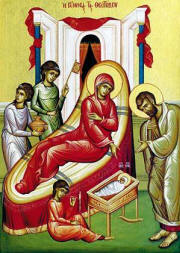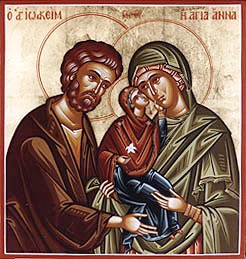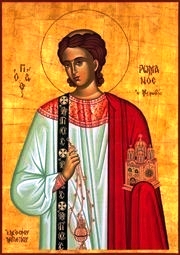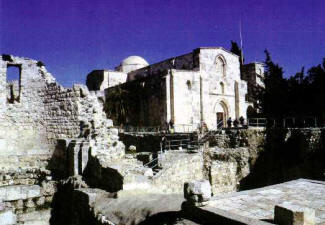
The Nativity of the Most-Holy Theotokos
September 8th
The Holy Virgin Mary was born of aged parents, Joachim
and Anna. Her father was of the lineage of David, and her mother of the
lineage of Aaron. Thus, she was of royal birth by her father and of
priestly birth by her mother. In this, she foreshadowed Him who would be
born of her as King and High Priest. Her parents were quite old and had
no children. Because of this they were ashamed before men and humble
before God. In their humility they prayed to God with tears, to bring
them joy in their old age by giving them a child, as He had once given
joy to the aged Abraham and his wife Sarah by giving them Isaac.

The Almighty and All-seeing God rewarded them with a joy that surpassed
all their expectations and all their most beautiful dreams. For He gave
them not just a daughter, but the Mother of God. He illumined them not
only with temporal joy, but with eternal joy as well. God gave them just
one daughter, and she would later give them just one grandson-but what a
daughter and what a Grandson!
Mary, Full of grace, Blessed among women, the Temple of the Holy Spirit,
the Altar of the Living God, the Table of the Heavenly Bread, the Ark of
God’s Holiness, the Tree of the Sweetest Fruit, the Glory of the race of
man, the Praise of womanhood, the Fount of virginity and purity-this was
the daughter given by God to Joachim and Anna. She was born in Nazareth,
and at the age of three, was taken to the Temple in Jerusalem. In her
young womanhood she returned again to Nazareth, and shortly thereafter
heard the Annunciation of the Holy Archangel Gabriel concerning the
birth of the Son of God, the Savior of the world, from her most-pure
virgin body.
-The Prologue from Ohrid: Lives of Saints
by St Nikolai Velimirovich, Bishop of Zica
The Feast of the Nativity of Mother of God is the first
major Holy Day of the new Church Year which began on September 1st. Why
was this day selected since it is not in the Holy Scripture? History
shows that St. Helena, the mother of Emperor Constantine, built a Church
in Jerusalem which was dedicated to the Nativity of our Lady. It was
said to be consecrated on the date of her nativity: September 8th.
The holy deacon Romanos, who lived in the 5th century, was a
 native
of Syria and later a deacon of Haghia Sophia in Constantinople. He is
known as the “sweet singer” and has written many prayers and hymns now
in use in the Eastern Church. He was probably the first one who brought
this day to the attention of the Church leaders. He wrote a hymn in
honor of her birth and spread the knowledge of it among the people.
native
of Syria and later a deacon of Haghia Sophia in Constantinople. He is
known as the “sweet singer” and has written many prayers and hymns now
in use in the Eastern Church. He was probably the first one who brought
this day to the attention of the Church leaders. He wrote a hymn in
honor of her birth and spread the knowledge of it among the people.
Both St. Andrew of Crete and St. John of Damascus also wrote much about
this event. Our holy father Andrew of Crete said: “This day is for us
the beginning of all holy days. It is the door to kindness and truth.
Today is arranged for the Creator of all, an inspired Church and
creation prepares itself to become the divine dwelling place of its
Creator.”
As it is the first major holy day of the new Church Year, it sets the
theme for the entire year: God’s inexpressible love for all of us and
our response to that love involves striving to live in grace. Amen.
“The day of the Nativity of the Theotokos is the feast of joy for the
whole world, because through the Theotokos the entire human race was
renewed and the grief of the first mother Eve was changed into joy.”
Our venerable father John of Damascus

According to one Christian tradition, the Most Holy
Theotokos was born in a cave near the Bethesda pool where Christ Our
Savior would one day perform miracles of faith. This opinion rests upon
the testimony of St. Sophronios, St. John Damascene, and upon the
evidence of the recent finds in the Probatica. The Crusaders believed
that a grotto they discovered next to the reservoir ruins was the
birthplace of the Theotokos, the home of her parents: the holy and
righteous Joachim and Anna. They incorporated the cave into a powerfully
impressive Church in honor of the holy and righteous Anna.
Unlike other Crusader Churches, St. Anna's was not destroyed by the
Mamelukes who captured the Holy Land in the twelfth century. Instead,
Mameluke commander Saladin converted the Church into an Islamic seminary
and left it whole. If you read Arabic you will find the name Salahiya
(of Saladin) in an inscription above the entrance. Today this historical
Church in honor of St. Anna belongs to the French government and is run
by the White Fathers, an order of the Catholic Church named for the
color of their robes.
Copyright 2019.St. George UGCC. All Rights Reserved.